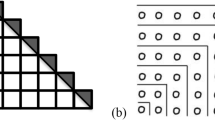Abstract
Visualization is a powerful tool for understanding and solving mathematical problems. The use of Venn diagrams to visualize set expressions, however, is problematic for many students and may actually hinder their problem-solving efforts. In this study, 92 university students construct visual representations of eight set expressions. Through the use of a production system model and detailed analyses of students' work and verbal protocols, it is discovered that (1) competent and error-prone students construct and use procedures to complete set translation tasks, and (2) two-thirds of the observed errors arise from the consistent implementation of ill-formed procedures. The procedural origins of students' errors are identified and conjectures are offered regarding the perceptions and experiences that lead to the development of erroneous translation procedures.
Similar content being viewed by others
References
AndersonJ.R. and JeffriesR.: 1985, ‘Novice LISP errors: Undetected losses of information from working memory’, Human-Computer Interaction 1, 107–131.
AndersonJ.R., PirolliP., and FarrellR.: 1988, ‘Learning to program recursive functions’, in M.T.H.Chi, R.Glaser, and M.J.Farr (Eds.), The Nature of Expertise, Lawrence Erlbaum, Hillsdale, N.J.
Ben-ChaimD., LappanG., and HouangR.T.: 1989 ‘The role of visualization in the middle school mathematics curriculum’, FOCUS on Learning Problems in Mathematics 11, 49–60.
BrownJ.S. and BurtonR.R.: 1978, ‘Diagnostic models for procedural bugs in basic mathematical skills’, Cognitive Science 2, 155–192.
BrownJ.S. and VanLehnK.: 1980, ‘Repair theory: A generative theory of bugs in procedural skills’, Cognitive Science 4, 379–426.
GiordanoG.: 1990, ‘Strategies that help learning disabled students solve verbal mathematical problems’, Preventing School Failure 35, 24–28.
Greeno, J.G., Magone, M.E., Rabinowitz, M., Ranney, M., Strauch, C., and Vitolo, T.M.: 1985, Investigations of a Cognitive Skill, ERIC Document Reproduction Service No. ED 267 096, Columbus, OH.
HarelG.: 1989, ‘Learning and teaching linear algebra: Difficulties and an alternative approach to visualizing concepts and processes’, FOCUS on Learning Problems in Mathematics 11, 139–148.
Kirshner, D.: 1990, ‘Acquisition of algebraic grammar’, in Proceedings of the Fourteenth International Conference for the Psychology of Mathematics Education, Mexico City, Mexico.
LarkinJ.H.: 1989, ‘Robust performance in algebra: The role of problem representation’, in S.Wagner and C.Kieran (Eds.), Research Issues in the Teaching and Learning of Albebra, National Council of the Teachers of Mathematics, Reston, VA.
MatzM.: 1981, ‘Towards a process model of high school algebra errors’, in D.H.Sleeman and J.S.Brown (Eds.), Intelligent Tutoring Systems, Academic Press, London.
NechesR., LangleyP., and KlahrD.: 1987, ‘Learning, development, and production systems’, in D.Klahr, R.Neches, and P.Langley (Eds.), Productions System Models of Learning and Development, MIT Press, Cambridge, MA.
NelsonD.W.: 1983, ‘Math is not a problem... when you know how to visualize it’, Instructor 93, 54–55.
NoddingsN.: 1990, ‘Constructivism in Mathematics Education’, in R.B.Davis, C.Maher, and N.Noddings (Eds.), Constructivist Views on the Teaching and Learning of Mathematics (Journal for Research in Mathematics Education, Monograph Number 4), National Council of the Teachers of Mathematics, Reston, VA.
NormanD.A.: 1981, ‘Categorization of action slips’, Psychological Review 88, 1–15.
PayneS.T. and SquibbH.R.: 1990, ‘Algebra malrules and cognitive accounts of error’, Cognitive Science 14, 445–481.
PimmD.: 1987, Speaking Mathematically: Communication in Mathematics Classrooms, Routledge & Kegan Paul, London.
RadatzH.: 1979, ‘Error analysis in mathematics education’, Journal for Research in Mathematics Education 10, 163–173.
SchoenfeldA.H.: 1982, ‘Some thoughts on problem-solving research and mathematics education’, in F.K.Lester and J.Garofalo (Eds.), Mathematical Problem Solving: Issues in Research, Franklin Institute Press, Philadelphia.
SleemanD.H.: 1984, ‘An attempt to understand students' understanding of basic algebra’, Cognitive Science 8, 387–412.
TallD. and ThomasM.: 1989, ‘Versatile learning and the computer’, FOCUS on Learning Problems in Mathematics 11, 117–125.
VanLehnK.: 1982, ‘Bugs are not enough: Empirical studies of bugs, impasses, and repairs in procedural skills’, The Journal of Mathematical Behavior 3, 3–71.
VanLehnK.: 1990, Mind Bugs: The Origins of Procedural Misconceptions, MIT Press, Cambridge, MA.
VanLehnK. and BallW.: 1991, ‘Goal reconstruction: How Teton blends situated action and planned action’, in K.VanLehn (Ed.), Architectures for Intelligence, Lawrence Erlbaum, Hillsdale, NJ.
VanLehnK., BallW., and KowalskiB.: 1989, ‘Non-LIFO execution of cognitive procedures’, Cognitive Science 13, 415–465.
WalkerdineV.: 1988, The Mastery of Reason, Routledge & Kegan Paul, London.
YoungR.M. and O'SheaT.: 1981, ‘Errors in children's subtraction’, Cognitive Science 5, 153–177.
Author information
Authors and Affiliations
Additional information
Notes
This article is based on the author's doctoral dissertation completed in 1992 at Indiana University under the direction of Frank K. Lester.
Rights and permissions
About this article
Cite this article
Hodgson, T. Students' ability to visualize set expressions: An initial investigation. Educ Stud Math 30, 159–178 (1996). https://doi.org/10.1007/BF00302628
Issue Date:
DOI: https://doi.org/10.1007/BF00302628




